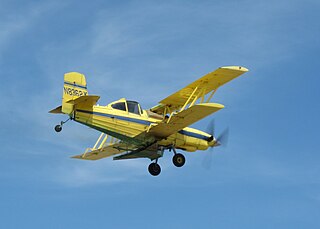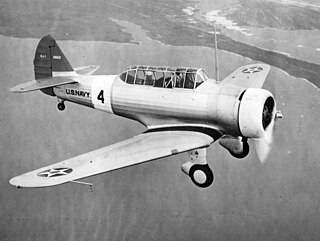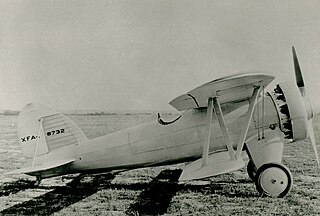
The Vought OS2U Kingfisher is an American catapult-launched observation floatplane. It was a compact mid-wing monoplane, with a large central float and small stabilizing floats. Performance was modest because of its low-powered engine. The OS2U could also operate on fixed, wheeled, taildragger landing gear.

The Douglas Dolphin is an American amphibious flying boat. While only 58 were built, they served a wide variety of roles including private air yacht, airliner, military transport, and search and rescue.

The Grumman G-164 Ag Cat is a single-engined biplane agricultural aircraft, developed by Grumman in the 1950s.

The Boeing P-12 or Boeing F4B is an American pursuit aircraft that was operated by the United States Army Air Corps, United States Marine Corps, and United States Navy. It was the chief fighter aircraft in American service during the early 1930s but also used internationally. By the late 1930s it was replaced in front-line duty by newer designs, but it was still used for training into the early 1940s. Many variants of the aircraft were developed. In the 21st century a handful of surviving air frames are on display in museums.

The North American BT-9 was the United States Army Air Corps (USAAC) designation for a low-wing single engine monoplane primary trainer aircraft that served before and during World War II.

The Boeing YB-9 was the first all-metal monoplane bomber aircraft designed for the United States Army Air Corps. The YB-9 was a much enlarged twin-engine development of Boeing's single-engine Model 200 Monomail commercial transport.

The General Aviation XFA was an American biplane fighter aircraft built by the General Aviation Company for the United States Navy.

The Boeing F2B was a biplane fighter aircraft of the United States Navy in the 1920s, familiar to aviation enthusiasts of the era as the craft of the Three Sea Hawks aerobatic flying team, famous for its tied-together formation flying.

The Boeing F3B was a biplane fighter and fighter bomber that served with the United States Navy from 1928 into the early 1930s.

The Boeing XF6B-1 / XBFB-1 was Boeing's last biplane design for the United States Navy. Only the one prototype, Model 236, was ever built; although first flying in early 1933, it rammed into a crash barrier in 1936 and the design was not pursued further.

The Curtiss F6C Hawk was a late 1920s American naval biplane fighter aircraft. It was part of the long line of Curtiss Hawk airplanes built by the Curtiss Aeroplane and Motor Company for the American military.

The Curtiss F7C Seahawk was a carrier-capable biplane fighter aircraft of the United States Navy Marine Corps in the late 1920s and early 1930s.

The Vought XF2U was a prototype biplane fighter aircraft evaluated by the United States Navy at the end of the 1920s, but was already outclassed by competing designs and never put into production.

The XP-13 Viper was a prototype biplane fighter aircraft designed by the American company Thomas-Morse Aircraft Corporation. The airplane was delivered to the United States Army in 1929, but they did not adopt it.

The Vought O2U Corsair was a 1920s biplane scout and observation aircraft. Developed by Vought Corporation, the O2U was ordered by the United States Navy (USN) in 1927. Powered by a 400 hp (298 kW) Pratt & Whitney R-1340 engine, it incorporated a steel-tube fuselage structure and a wood wing structure with fabric covering. Many were seaplanes or amphibians.

The Boeing P-29 and XF7B-1 were an attempt to produce a more advanced version of the highly successful P-26. Although slight gains were made in performance, the U.S. Army Air Corps and U.S. Navy did not order the aircraft.

The Loening OL, also known as the Loening Amphibian, was an American two-seat amphibious biplane designed by Grover Loening and built by Loening for the United States Army Air Corps and the United States Navy.

The Curtiss XBTC was a prototype single-seat, single-engined torpedo/dive bomber developed during World War II for the United States Navy. Four aircraft were ordered, powered by two different engines, but the two aircraft to be fitted with the Wright R-3350 radial engine were cancelled in late 1942, leaving only the pair using the Pratt & Whitney R-4360 radial. By this time, Curtiss Aircraft was overwhelmed with work and the Navy gave the XBTC-2 prototypes a low priority which delayed progress so the first flight did not take place until the beginning of 1945. One aircraft crashed in early 1947 and the other was disposed of later that year.

The Wright XF3W was an American racing aircraft built by Wright Aeronautical for the United States Navy.

The Berliner-Joyce XF2J was the company's second biplane fighter for the United States Navy. The XF2J was ordered on 30 June 1931 and although designated as a two-seat fighter, it was used as an observation aircraft.




















